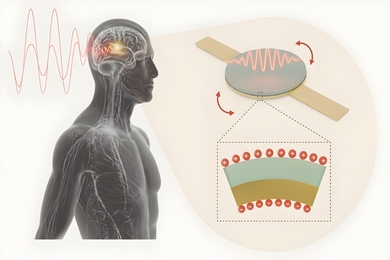Since the 1970s, when early autonomous underwater vehicles (AUVs) were developed at MIT, Institute scientists have tackled various barriers to robots that can travel autonomously in the deep ocean. This four-part series examines current MIT efforts to refine AUVs’ artificial intelligence, navigation, stability and tenacity.
If an underwater robot is to open a valve or repair a damaged pipe, it needs to anchor itself to a solid surface so it can apply force to carry out its task without pushing itself away. It then needs to detach and move on to its next assignment.
A group of MIT researchers has designed a “controllable adhesion system” for underwater robots that offers the needed features: a high holding force on various geometries and textures, low energy consumption, chemical resistance to seawater, and low maintenance requirements.
Underwater vehicles have become good at using propellers and thrusters to stay in one place, even in strong currents. But holding on to a surface while exerting force to do a job is quite another challenge — one that Sangbae Kim, the Esther and Harold E. Edgerton Assistant Professor of Mechanical Engineering, and his collaborators have been tackling for the past year. They are working on several approaches, but their best success to date has come using a magnet, or more specifically, an electromagnet: Take a bar of iron, wrap a coil of wire around it, send an electrical current through it and you have a magnet. Switch off the current, and the magnetic field disappears.
But there’s a drawback to this approach: You need to send electrical current to the robot all the while it’s completing its task. Stop the current and the magnet goes neutral, and the robot can float away.
So Kim’s group turned to “controllable electromagnets” — magnetic devices that can easily be turned on and off using little energy. The concept has been around for 30 years and has been used for various applications. However, there is little published information on how these devices are designed, what they’re made of and how they work, so the researchers had to develop an understanding of the fundamentals involved.
Guided by that understanding, they designed a module consisting of two parallel bar magnets next to each other. One is a very strong magnet made of neodymium, iron and boron (NIB). The other is a weak magnet made of aluminum, nickel and cobalt (alnico). Around the alnico magnet is a coil through which an electrical current can flow.
To start out, the two magnets have their north and south magnetic poles at opposite ends — a configuration in which the magnetic fields cancel each other out. The combination is neutral; the module is not magnetic. But send a pulse of current through the coil, and the polarity of the alnico magnet changes — that is, its north and south poles swap places. Now the module is a strong electromagnet, perfect for anchoring a robot on a pipe or a ship’s hull. Send another pulse of current, and the polarity of the alnico magnet changes back. The module is neutralized, the robot released.
The best feature is that no energy is required to keep the module in either state, as a magnet or a nonmagnet. “Instead of having to spend energy continuously while the robot is working, with our system, you need to spend a pulse of energy only when you switch the state,” Kim says.
Based on results from experiments and simulations, the researchers created a novel design with improved performance. In the new design, the two magnets are concentric rather than parallel bars. At the center is a cylinder-shaped alnico magnet, and surrounding it is an NIB magnet shaped like a hollow tube. A coil around the outside can carry current to switch the polarity of the alnico magnet. (The NIB magnet is too strong to be affected.) In this configuration, the module can still be switched on and off. But now the whole structure can be covered by a steel cup — an outside shell that confines the magnetic field to the open side and minimizes its leakage when the module is clamped on to a surface.
To determine the strength of their prototypes, they used a materials-testing machine that measures the force exerted by a magnet at gradually increasing distances from an iron plate. The tests revealed certain behaviors about their different designs. For example, they confirmed that the cylinder type is stronger than the bar type. But the results also showed that the cylinder type performs best when the alnico magnet is tall: specifically, five times taller than it is wide. The initial prototypes were fairly short and wide, and those modules quickly demagnetized a short distance from the iron plate. New prototypes with the taller profile performed markedly better.
In other work, the researchers created an electric circuit that pulses just enough energy at the right voltage to cause the alnico magnet to change orientation. Tests confirmed that little energy is needed to achieve almost all the theoretically possible “latching force” and even less energy is needed to deactivate the module.
The team also developed a manufacturing technique that combines multiple modules. In one example, they mount three modules on a base of silicon rubber. This three-module unit is flexible enough to conform to a curved surface — for example, wrapping around a pipe — and the individual modules don’t interfere with one another.
Much work remains. In particular, the researchers need to test their adhesion system on samples of actual pipes and other equipment used by industry. One concern is that their module may not be able to attach directly to metal surfaces because of protective plastic coatings or deposits of biological organisms on structures. The team needs to establish the impact of such interfering layers on performance and adapt designs to take those layers into account.
Kim is pleased with their progress to date. “We’ve developed a good fundamental understanding and have made some promising prototypes,” he says. “Now we want to implement our magnetic adhesion system by collaborating with other researchers who are designing robots to perform underwater maintenance and repairs.”
If an underwater robot is to open a valve or repair a damaged pipe, it needs to anchor itself to a solid surface so it can apply force to carry out its task without pushing itself away. It then needs to detach and move on to its next assignment.
A group of MIT researchers has designed a “controllable adhesion system” for underwater robots that offers the needed features: a high holding force on various geometries and textures, low energy consumption, chemical resistance to seawater, and low maintenance requirements.
Underwater vehicles have become good at using propellers and thrusters to stay in one place, even in strong currents. But holding on to a surface while exerting force to do a job is quite another challenge — one that Sangbae Kim, the Esther and Harold E. Edgerton Assistant Professor of Mechanical Engineering, and his collaborators have been tackling for the past year. They are working on several approaches, but their best success to date has come using a magnet, or more specifically, an electromagnet: Take a bar of iron, wrap a coil of wire around it, send an electrical current through it and you have a magnet. Switch off the current, and the magnetic field disappears.
But there’s a drawback to this approach: You need to send electrical current to the robot all the while it’s completing its task. Stop the current and the magnet goes neutral, and the robot can float away.
So Kim’s group turned to “controllable electromagnets” — magnetic devices that can easily be turned on and off using little energy. The concept has been around for 30 years and has been used for various applications. However, there is little published information on how these devices are designed, what they’re made of and how they work, so the researchers had to develop an understanding of the fundamentals involved.
Guided by that understanding, they designed a module consisting of two parallel bar magnets next to each other. One is a very strong magnet made of neodymium, iron and boron (NIB). The other is a weak magnet made of aluminum, nickel and cobalt (alnico). Around the alnico magnet is a coil through which an electrical current can flow.
To start out, the two magnets have their north and south magnetic poles at opposite ends — a configuration in which the magnetic fields cancel each other out. The combination is neutral; the module is not magnetic. But send a pulse of current through the coil, and the polarity of the alnico magnet changes — that is, its north and south poles swap places. Now the module is a strong electromagnet, perfect for anchoring a robot on a pipe or a ship’s hull. Send another pulse of current, and the polarity of the alnico magnet changes back. The module is neutralized, the robot released.
The best feature is that no energy is required to keep the module in either state, as a magnet or a nonmagnet. “Instead of having to spend energy continuously while the robot is working, with our system, you need to spend a pulse of energy only when you switch the state,” Kim says.
Based on results from experiments and simulations, the researchers created a novel design with improved performance. In the new design, the two magnets are concentric rather than parallel bars. At the center is a cylinder-shaped alnico magnet, and surrounding it is an NIB magnet shaped like a hollow tube. A coil around the outside can carry current to switch the polarity of the alnico magnet. (The NIB magnet is too strong to be affected.) In this configuration, the module can still be switched on and off. But now the whole structure can be covered by a steel cup — an outside shell that confines the magnetic field to the open side and minimizes its leakage when the module is clamped on to a surface.
To determine the strength of their prototypes, they used a materials-testing machine that measures the force exerted by a magnet at gradually increasing distances from an iron plate. The tests revealed certain behaviors about their different designs. For example, they confirmed that the cylinder type is stronger than the bar type. But the results also showed that the cylinder type performs best when the alnico magnet is tall: specifically, five times taller than it is wide. The initial prototypes were fairly short and wide, and those modules quickly demagnetized a short distance from the iron plate. New prototypes with the taller profile performed markedly better.
In other work, the researchers created an electric circuit that pulses just enough energy at the right voltage to cause the alnico magnet to change orientation. Tests confirmed that little energy is needed to achieve almost all the theoretically possible “latching force” and even less energy is needed to deactivate the module.
The team also developed a manufacturing technique that combines multiple modules. In one example, they mount three modules on a base of silicon rubber. This three-module unit is flexible enough to conform to a curved surface — for example, wrapping around a pipe — and the individual modules don’t interfere with one another.
Much work remains. In particular, the researchers need to test their adhesion system on samples of actual pipes and other equipment used by industry. One concern is that their module may not be able to attach directly to metal surfaces because of protective plastic coatings or deposits of biological organisms on structures. The team needs to establish the impact of such interfering layers on performance and adapt designs to take those layers into account.
Kim is pleased with their progress to date. “We’ve developed a good fundamental understanding and have made some promising prototypes,” he says. “Now we want to implement our magnetic adhesion system by collaborating with other researchers who are designing robots to perform underwater maintenance and repairs.”






